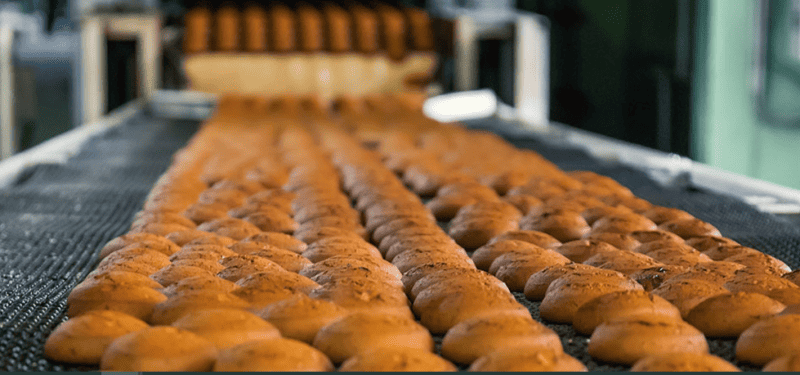Introduction
In the baking industry, cooling plays a vital role in preserving the quality and extending the shelf life of various baked goods. One of the key components used for efficient cooling operations is the spiral freezer mesh belt. This article aims to explore the importance, working principle, benefits, maintenance, and common issues associated with spiral freezer mesh belts in the baking industry.

What is a Spiral Freezer Mesh Belt?
A spiral freezer mesh belt is a specialized conveyor belt designed for the transportation and cooling of baked goods in a spiral freezer. It is made from high-quality stainless steel or other food-grade materials to ensure hygiene and durability. The belt consists of a series of closely spaced rods or wires that form a continuous mesh surface. This mesh design allows for efficient airflow and quick cooling of baked products.
Importance of Cooling in the Baking Industry
Proper cooling is crucial in the baking industry as it helps maintain the quality, taste, and texture of baked goods. During the baking process, heat is transferred to the products, and if not cooled down quickly and efficiently, it can lead to undesirable outcomes such as overbaking, moisture loss, and loss of product integrity. The spiral freezer mesh belt facilitates rapid cooling by providing a consistent and controlled environment for the baked goods.

Working Principle of Spiral Freezer Mesh Belt
When the baked goods enter the spiral freezer, they are placed on the mesh belt, which moves in a continuous spiral motion. The belt carries the products through a freezing chamber where cold air is circulated. As the products travel along the belt, the airflow through the mesh cools them evenly and gradually. The spiral motion ensures that the products spend sufficient time in the freezer, allowing for proper cooling and maintaining product quality.

Benefits of Using Spiral Freezer Mesh Belt
- 1.Efficient Cooling: The design of the spiral freezer mesh belt promotes optimal airflow, ensuring even cooling of baked goods.
- 2.Space Optimization: Spiral freezers with mesh belts occupy less floor space compared to traditional flat belt conveyors, making them suitable for bakeries with limited space.
- 3.High Capacity: Spiral freezers can handle a large volume of products, allowing for increased production efficiency.
- 4.Versatility: The mesh belt is compatible with various baked goods, including bread, pastries, cookies, and more.
- 5.Hygienic and Easy to Clean: Spiral freezer mesh belts are made from food-grade materials and can be easily cleaned, maintaining a hygienic production environment.
Factors to Consider When Choosing a Spiral Freezer Mesh Belt
- 1.Material Quality: Ensure the mesh belt is made from high-quality stainless steel or food-grade materials to meet industry standards.
- 2.Mesh Configuration: Consider the spacing and size of the mesh openings to ensure proper airflow and cooling efficiency for your specific baked goods.
- 3.Belt Strength and Durability: Choose a belt with sufficient strength and durability to withstand the weight and demands of your bakery's production.
- 4.Customization Options: Look for suppliers who offer customization options to fit the specific requirements of your bakery.

Maintenance and Cleaning of Spiral Freezer Mesh Belt
Regular maintenance and cleaning are essential to ensure the longevity and optimal performance of the spiral freezer mesh belt. Follow these guidelines:
- 1.Regularly inspect the belt for any signs of wear, damage, or misalignment.
- 2.Clean the belt after each use with food-safe cleaning agents and sanitizers.
- 3.Lubricate the belt's moving parts to prevent friction and ensure smooth operation.
- 4.Train staff on proper handling and maintenance procedures.
Common Issues and Troubleshooting
1.Belt Misalignment: Check for any obstructions or loose components that might cause the belt to deviate from its intended path. Adjust or tighten as necessary.
2.Excessive Belt Tension: Excessive tension can cause premature wear and tear on the belt. Adjust the tension to the manufacturer's recommended specifications.
3.Mesh Damage or Blockage: Inspect the mesh for any signs of damage or blockage that could hinder airflow. Replace damaged sections or clean out blockages.
Industry Trends and Innovations
1.Advanced Belt Materials: Manufacturers are exploring the use of new materials with enhanced properties, such as improved heat resistance or reduced friction.
2.Automated Cleaning Systems: Some spiral freezer mesh belts now feature automated cleaning systems, reducing manual labor and ensuring thorough sanitation.

Conclusion
The spiral freezer mesh belt is a crucial component in the baking industry for efficient cooling operations. Its design, material quality, and maintenance contribute to maintaining the quality, taste, and texture of various baked goods. By considering factors such as material quality, belt strength, and customization options, bakery owners can optimize their cooling processes and enhance production efficiency.
FAQs
1.Q: How often should I clean the spiral freezer mesh belt?
A:Cleaning the spiral freezer mesh belt after each use is recommended to maintain hygiene and prevent cross-contamination.
2.Q: Can the spiral freezer mesh belt handle gluten-free products?
A:Yes, the spiral freezer mesh belt is suitable for handling gluten-free products and can be customized to accommodate different product specifications.
3.Q:What is the typical lifespan of a spiral freezer mesh belt?
A:The lifespan of a spiral freezer mesh belt depends on various factors such as usage, maintenance, and product load. With proper care, it can last for several years.
4.Q:Are spiral freezer mesh belts suitable for large-scale industrial bakeries?
A:Yes, spiral freezer mesh belts are commonly used in large-scale industrial bakeries due to their high capacity and efficient cooling capabilities.
5.Q:Can the airflow through the mesh belt be adjusted?
A:Yes, the airflow through the mesh belt can be adjusted by controlling the fan speed and temperature settings in the spiral freezer.



